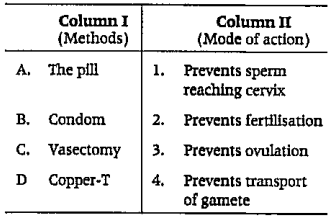Which of the following are the principal features of Government of India Act 1919? 1. Introduction of dyarchy in the executive government of the provinces. 2. Introduction of separate communal electorate for Muslims. 3. Devolution of legislative authority by the Centre to the Provinces. 4. Expansion and reconstitution of Central and Provincial Legislatures. a 1 2 and 3 b 1 2 and 4 c 2 3 and 4 d 1 3 and 4
The correct option: d 1 3 and 4
Related Solutions
Which of the following is/are the principal features(s) of the Government of India Act, 1919 ?
1. Introduction of dyarchy in the executive government of the provinces
2. Introduction of separate communal electorates for Muslims
3. Devolution of Legislative authority by the centre to the provinces
Select the correct answer using the codes given below:
View SolutionWhich of the following was/were the main feature(s) of the Government of India Act, 1919? 1. Introduction of separate electorates for Muslims 2. Devolution of legislative authority by the Centre to the Provinces 3. Expansion and reconstitution of Central and Provincial Legislatures Select the correct answer using the code given below:
View SolutionWhich of the following was/ were the main feature(s) of the Government of India Act, 1919 ?
1. Introduction of separate electorates for Muslims
Devolution of legislative authority by the centre
3. Expansion and reconstitution of Central and Provincial Legislatures
Select the correct answer using the code given below:
View SolutionThe Government of India Act, 1919 1. established a bicameral legislature at the Centre 2. introduced dyarchy in provincial executive 3. introduced a federal system of government in India Select the correct answer using the code given below.
View SolutionConsider the following statements-
The objective of the Montague-Chelmsford Reforms of 1919 was
1. o give power to the local government
2. To establish dyarchy in the provinces
3. The extension of provincial government
Which of these statements are correct?
View SolutionThese were included in prime elements of the Government of India Act, 1935-
1. Proivsion of Federation
2. Provision of Federation
3. Introduction of Dyarchy in Provinces
4. To Authorization of Federal Legislature.
Select the correct answer by using codes structure given below:
View SolutionConsider the following with reference to the provisions of Government of India Act, 1935' : 1. Establishment of an all-Indian Federation 2. Provincial autonomy, with a Government responsible to an elected legislature 3. Redistribution of provinces and the creation of two new provinces Which of these were embodied in the Government of India Act, 1935 ?
View SolutionStatement I: The Government of India Act, 1935 introduced Dyarchy at the Centre.
Statement II : The provincial autonomy was granted to the Provinces
View Solutionसम्बन्धो के प्रांत एव परिसर लिखो-
View SolutionWhich one of the following is NOT a feature of the Government of India Act of 1935 ? (a) Diarchy at the centre as well as in the provinces (b) A bicameral legislature (c) Provincial autonomy (d) An All India Federation
View SolutionConsider the following features : 1. Presence of a nominal or titular head of state 2. Collective responsibility of cabinet 3. Accountability of executive to the legislature 4. Separation of powers Which of these are the features of a parliamentary form of Government ?
View SolutionConsider the following statements :
The Government of India Act, 1935 provided for :
1. The provincial autonomy
2. The establishment of Federal Court
3. All Indian Federation at the Centre
Which of the statements given above are correct? (a) 1 and 2 (b) 2 and 3 (c) 1 and 3 (d) 1, 2 and 3
View SolutionConsider the following statements:
Some of the main features of the Government of India Act, 1935 were the:
1. Abolition of diarchy in the Governor's provinces.
2. The power of the Governors to veto legislative action and to legislate on their own.
3. Abolition of the principal of communal representation.
Which of the statements given above is/are correct?
View SolutionMatch the following. Codes A B C D (A) 4 3 1 2 (B) 2 4 1 3 (C) 3 4 2 1 (D) 3 4 1 2
View SolutionWhich of the following is in ascending order
A. 2/3, 3/4, 4/5, 1/2
B. 3/4, 4/5, 1/2, 2/3
C. 1/2, 2/3, 3/4, 4/5
D. 4/5, 1/2, 2/3, 3/4
View SolutionWhat is the correct sequence of the following events? 1. The Lucknow Pact 2. The introduction on Dyarchy 3. The Rowlatt Act 4. The Partition of Bengal
View Solutionनिम्नलिखित बिंदुओं को अंकित कीजिए |
View SolutionMatch the following list of animals with their level of organisation.

(A) (a - 2), (b - 3), (C-4), (d - 1)
(B) (a - 2), (b - 4), (C-3), (d - 1)
(C) (a - 4), (b - 1), (C-2), (d - 3)
(D) (a - 1), (b - 4), (C-3), (d - 2)
View SolutionMatch the following columns.

a) A-3, B- 1, C- 4 , D- 2 .
b) A- 4 , B- 1 , C- 2, D- 3.
c) A- 2 , B- 3, C- 1, D- 4.
d) A- 3, B- 4, C-1, D- 2.
View SolutionIf a=3^((1)/(4))+3^(-(1)/(4)) and b=3^((1)/(4))-3^(-(1)/(4)) then the value of 3(a^(2)+b^(2))^(2)
View Solution